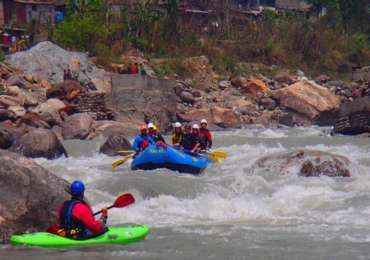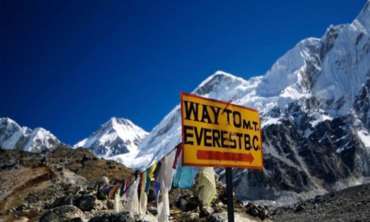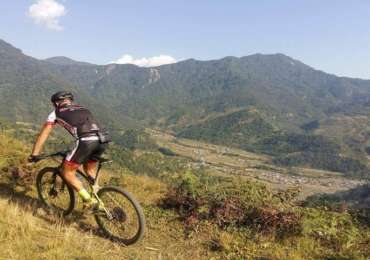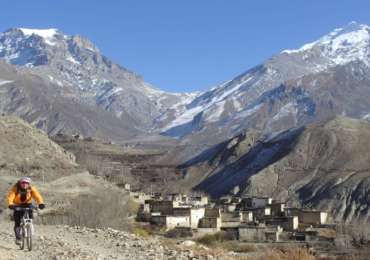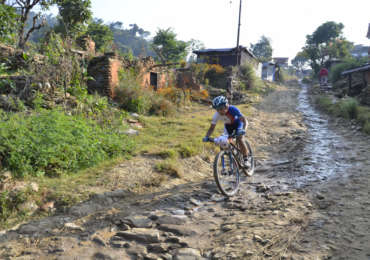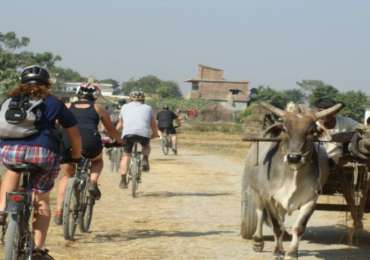Tamur is not readily available, hence to enjoy this river, you need to trek for about four days. However, you will not be disappointed, the trek in itself is equally exciting. You will be treading on narrow dirt tracks that join one typical village to another. The whole region is sparsely populated, and only a small portion of land serves for agriculture. You can view the glory of Mt. Kanchanjunga from the trekking routes.
The Tamur river has some 120 rapids within its rafting length of 131 kilometres. The initial parts of Tamur are tough. This river is for experienced guides and rafters/ kayakers, and you need to be very careful because there have been several fatalities recorded in this river. This river is very challenging and if you are looking for a huge adrenaline surge – Tamur is the river for you!
Day 01: Basantapur
We will either fly to Biratnagar (80 m) from Tribhuvan International Airport or drive to Basantapur. If you choose to fly, it will take about 45 minutes to reach Biratnagar, then from Biratnagar, we will take you to Basantapur by bus.
Please note – If you prefer to fly, you must mention this to our office personnel while booking for the expedition. Biratnagar is the second biggest city of Nepal and is located near the south-eastern border to India.
Day 02: Chauki
Our expedition will begin with a trek from Basantapur to Chauki, which takes around 4 to 5 hours. The trail is quite challenging, and we will employ porters to carry your personal gear bags. The guides will show you the way. By the time, we reach Chauki; we will be exhausted. In Chauki, we will be staying in a local tea house where we will enjoy our dinner too.
Day 03: Gupha Pokhari (2,900 m)
After breakfast, we will resume our trekking. After about 4 to 5 hours, we will reach Gupha Pokhari. Gupha Pokhari is a lake at the height of 2,900 metres and lies in Sankhuwasabha district.
The trail to Gupha Pokhari is equally fascinating; you will be witnessing beautiful landscape and diverse cultures. If you take this trip during the March to June season, you will get to experience different varieties of rhododendron in full bloom. From your trail, you will also be able to enjoy the views of Mt. Kanchanjunga (world’s third highest mountain, at 8,586 m) and Mt. Everest (world’s highest mountain, at 8,848 m). We will spend our night at Gupha Pokhari in our camp.
Day 04: Gorja (1,925 m)
After a hearty breakfast, we will continue our trek forwards, from Gupha Pokhari to Gorja. You will be amazed by the varieties of flora and fauna, you will see on the way. You will also have an opportunity to observe some of the most remote rural settlements in Nepal, and perhaps in the world. We will be staying at Gorja in our camp for the night.
Day 05: Dovan (730 m)
This is the final day of trekking. We will start from Gorja and reach Dovan in about 3 hours and set up our camp there. We will be spending our day for much-needed rest and prepare for running on Tamur, the next day.
Day 06: Kabeli Khola
By now, we will have trekked for 4 days; today the much-anticipated part of the Expedition – rafting starts. We will get to Kabeli Khola (River is called Khola in Nepali) from Dovan. We will prepare all the necessary gears, and the professional rafters will brief you on the safety measures. This day we will encounter some challenging white water rapids like House Rock (Class IV), Pariah Dog (Class IV+), Hodson’s Sandwich (Class IV+), Hodson’s Last Rite (Class IV+) while paddling for about 25 kilometres in Kabeli Khola. We will camp at a beach by the banks of Kabeli for that day.
Day 07: Hinwa Khola
We will raft to Hinwa Khola from Kabeli. The rapids become more challenging right from the beginning, but the rapids decrease in frequency once we cross the Limbu Bridge. While rafting we will come across white sandy beaches, blue water and sparsely populated area. We might be seeing more monkeys than people. As we raft downwards, we will see lower mountain regions. This region is near to Koshi Tappu Wildlife Reserve (75 m – 81 m). Hence you get to see various varieties of birds. Koshi Tappu is home to around 500 bird species. We will stop by the sandy beaches and set up our camp.
Day 08: Limbhu Khola
After breakfast, we will start rafting from Hinwa Khola to reach Limbhu Khola. At first, the river is flat and therefore we can loosen ourselves a bit and enjoy the landscape. Interested Kayakers may kayak in this region. On our way, we will be encountering few Class II or III rapids. Over the river, we will occasionally see suspension bridges. We will be spending that night in the Camp, by the side of Limbhu Khola.
Day 09: Mulghat (203 m)
By this day, we will have rafted for four days on some of the most exciting and vigorous rapids. So, on this day, we will get a chance to relax a bit. As we raft, we will be passing only a few small rapids. In around four hours, we will reach Mulghat from Limbhu Khola. We will spend the night at Mulghat.
Day 10: Tribeni
The next day, we will paddle on Tamur River to reach Tribeni (Tribeni means confluence of three rivers in Nepali.) On our way, we will be passing through 30 exciting continuous rapids; the most notable ones are – Ashram (Class IV+), Hell Hole (Class IV) and Bat Below (Class IV). We will be setting up our camp for that day at Tribeni, by the side of Sun Koshi.
Day 11: Chatara to Kathmandu
After breakfast, we will raft until we reach the famous Hindu temple of Baraha. We will spend some time sightseeing, and then paddle to Chatara – our final put out point. From Chatara transfer to Biratnagar and take flight to Kathmandu.
On arrival, transfer to the hotel.
Overnight in Kathmandu.
Day 12: Kathmandu
After breakfast, you can go for last minute souvenir shopping, again if you require, our guides will recommend the best places to buy souvenirs from. In the evening, you will have a farewell dinner with our office representatives (along with guides) in a typical Nepali restaurant. We will drop you back to your hotel.
Day 13: Depart Kathmandu
Transfer to airport for flight to onward destination.
| Places | Night( s) | Hotels / Lodges / Camp |
| Basantpur | 01 | Tourist Lodge |
| Chauki | 01 | Tourist Lodge |
| Gupha Pokhari | 01 | Tourist Lodge |
| Gorja | 01 | Camp |
| Dovan | 01 | Camp |
| Kabeli Khola | 01 | Camp |
| Hinwa Khola | 01 | Camp |
| Limbhu Khola | 01 | Camp |
| Mulghat | 01 | Camp |
| Tribeni | 01 | Camp |
| Kathmandu | 02 | Mulberry Hotel |
– Professional English speaking licensed guides, highly trained and safety certified to international standards in Whitewater River Guiding, Swift Water Rescue, and Wilderness First Aid
– Professionally trained and certified safety kayakers.
– Gear raft support
– Quality rafting and kayaking equipment, including boats, kayaks, helmets, paddles, PFDs, dry bags and Pelican boxes.
– 12 Nights Accommodation as per program.
– Accommodation in a camp and all necessary facilities including two man tents, shelters, simple mattress and sleeping bag, toilet tents, etc.
– Treated drinking water
– All transfers, sightseeing, excursions by private driver and vehicle.
– River permits.
– Entrance fees (for Day 2).
– Industry standard first aid kits.
– Hotel cost includes a BB, twin sharing basis.
– Visas, flights, other taxes etc.
– Personal items like toiletries, clothing, camera etc.
– Alcohol and other packed food.
– Insurance policy: paddlers need to have their own insurance since we only provide insurance to our crew.
– Tips for guides – we pay our guides and porters fairly but if you want you can tip them personally.
– Accommodation in good hotels.
– Check-in / out time is 12 noon at most of the hotels.
– Extension to other places is also possible with a minimal extra cost.
– Additional nights are available at each place with minimal supplement.
– A visa is required and must be obtained prior to your departure from your Country.
– If quoted hotel is not available, we will provide one of a similar category and standard.
– Small deviations in the tour program are sometimes necessary, depending on weather, road conditions, flight schedules and room availability.
– In case the government changes presently applicable taxes, increase in airlines prices, fuel surcharge our rates will need to be adjusted accordingly.
– Sometimes, there is no relevance between the distance and time of travelling, as it depends upon the condition of the roads and congestion of the traffic.
– While every effort will be made to maintain the itinerary, in view of local strikes etc that are beyond our control all schedule and itineraries are subject to last moment changes.
– Clients must be fully insured, as the company cannot accept liability for loss or damage to client’s property, medical emergencies or any other loss suffered by them whilst on tour.
– In Case of issuing Domestic or International air tickets, SGV is not responsible for any refund if the flight is delayed or cancelled, as it is the responsibility of airline.



